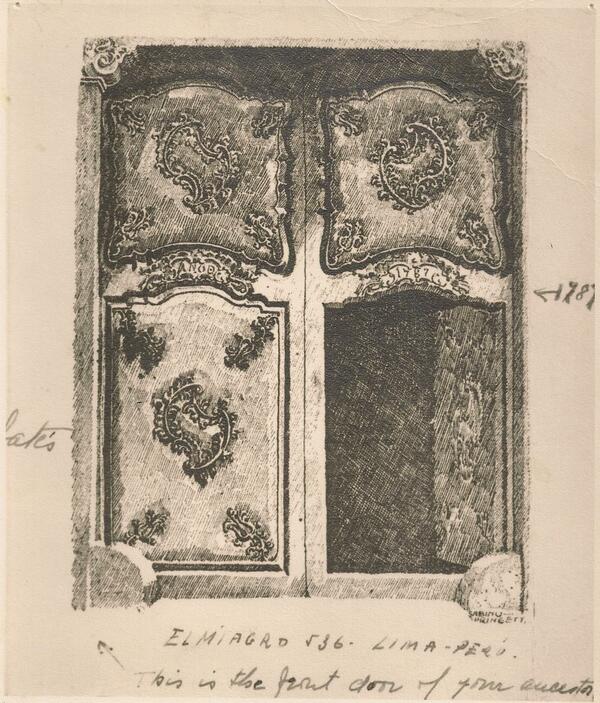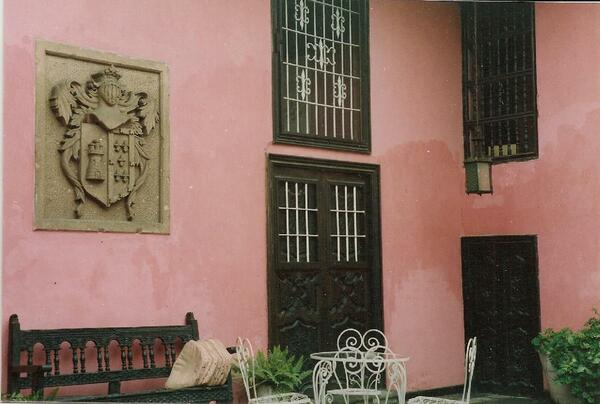Where was Laurita Perez born?
Where was Laurita Perez born?
The first page of the Peru Saga by
Eleanor Perez is illustrated by a picture with the hand written
caption "Beautiful Door-way entrance to the `Ancestral' Perez house in
Lima, Peru, where Laurita was born March 5, 1890." The first page has
another reference to the house: "The Perez home (built on the outskirts
of Lima in 1787) where Laurita was born, was the "Family Homestead" of
father's Uncle, Jose Perez y Rodolfo." The section of the "Saga"
outlining the family includes the paragraph:
"Laurita Victoria (`little Laura' for Mother), born in the
Jose Perez Family Homestead, on the outskirts of Lima, Peru, March 5,
1890. Our Cousin, Elvirita Perez Moravski, wrote me recently that the
property has been bought by the City of Lima. They plan to make it into
a fashionable night spot and restaurant."
The doorway entrance to the Perez house in the Peru Saga is shown below

(click here for a high resolution image) .
The high resolution image shows that this picture is of an engraving,
and at the lower right is the name of the presumed artist, Sabino
Springett (with most of the second S missing). The Spanish Wikipedia
page for Sabino Springett indicates that he was a "Peruvian painter,
engraver and afiche" (Google translation), was born in Quilcata,
Ayacucho on July 12, 1913, and died in Lima in August 2006.
This image of the door engraving has the address "El Miagro 536, Lima,
Peru" handwritten on it, but there is no "El Milagro" street in the old
part of Lima.
This picture and the reference in the Peru Saga to the house where
Laurita Perez was born intrigued Joanna Parker (niece of Lonna P Evans)
to investigate when she was in Lima. In May 2019 she wrote to me:
"I was living in Lima for a short while in 1989 as my research job was
being formulated, and a Peruvian friend helped me track down the
ancestral home, which is a fascinating story in itself. We frequented
the restaurant (Las Trece Monedas) a few times -- the first two times
before I realized it was originally our family home!"
Later she wrote to explain the address discrepancy: "Lima in olden
times was not the huge sprawling city is it now. Calling the location of
the house 'the outskirts', is probably accurate for the time. Now, it's
considered in the city center. The street names also threw us when
trying to find the house, as Calle El Milagro was the street name. There
is no such street in the city center. My companion in the quest for the
house location told me that in olden times, different names were often
given to each block of a street. We acquired an ancient atlas of the
city from a friend's great-aunt and, sure enough, 4 blocks from the
Central Plaza there was a short street called El Milagro, and it
corresponded to where the house is. That whole street over time became
known by the one name of Jiron Ancash."
In 1990 Joanna sent photographs of the Casa de las Trece Monedas
restaurant to Lonna P Evans.

Joanna's picture of the Trece Monedas courtyard wall
Joanna's visit to the Casa de las Trece Monedas and these photographs
inspired Lonna Evans to travel to Lima in 1991 to see the house and take
a group tour of Peru.
The Casa de las Trece Monedas (House of the Thirteen Coins) is now a
tourist attraction with the address Jiron Ancash 542, Cercado de Lima.
For example,
this web page has pictures and the following description:
This single-story residence originally belonging to the
Lopez-Flores family dates back to the mid 18th century. ... The
architectural style of the Casa de las Trece Monedas perfectly fits in
18th century Lima. Still preserved are the original beautifully carved
wooden doors, windows and bars. The patio of the Casa de las Trece
Monedas (House of the Thirteen Coins) shows a classic Spanish influence.
The Casa de las Trece Monedas today is home to the National
Afroperuvian Museum (Museo Nacional Afroperuano). The "Casa de las
Trece Monedas" ("House of the Thirteen Coins" named after the thirteen
coins in the coat of arms of the family) housed for a long time a
restaurant with the same name. ...
Recent pictures from Google of the National Afroperuvian Museum
entrance
door and the
coat
of arms in the courtyard clearly show that this is same location as
the illustration in the Peru Saga and the same as the restaurant that
Joanna visited.
Another web page in Spanish about Casa de las Trece Monedas
(http://elgustodeviajar.blogspot.com/2013/06/casa-de-las-trece-monedas-lima-peru.html)
gives a little more about the history of this house. Joanna's translation:
The house belonged to the Lopez-Flores family, counts of Puente
Pelayo. It takes its name from the 13 coins that form part of the
owner's family coat of arms. In 1972, it was declared a National
Cultural Monument. The earthquakes of 1687 and 1746 left little of its
original construction behind. The current structure dates from 1780. In
the beginning of the 19th centure, it was known as the house of the
archbishop because there was a prelate of Lima living there. In 1947,
Bernardo Moravsky rented it, restoring it in order to live there, and he
put up his family's coat of arms on the main door which had on one half
5 lily flowers and on the other half, 13 coins."
Bernardo Moravsky is a rather unique name in Lima, and I believe this
is Bernardo Moravsky, Jr., born 10 Aug 1906, son of Elvira Perez Rodulfo
(see Perez families in Peru).
Thus, Bernardo Moravsky, Jr. was a second cousin of Laurita Perez.
The best way to confirm where Laurita Perez was born is to find her Lima birth registration, which
I did on FamilySearch.org. This shows that she was born on 5 Mar 1890
in district 4, block 7 of Ancachs antes Frimiturias, number 159. This
address doesn't seem to match Calle El Milagro 536 or Jiron Ancash 542.
However, a Google search indicates that Ancachs Peru is a version of
Ancash Peru, which is a "Peruvian region north of Lima bordering the
Pacific Ocean." If the block numbering started at the west end of Jiron
Ancash, then using a 1904 map of Lima, block 7 would be the correct
block for Casa de las Trece Monedas. We need more information on this
older style of Lima addresses to firmly conclude that Laurita Perez was
born in Casa de las Trece Monedas.
Eleanor Perez' Peru Saga recounts that Uncle Pepe's (Jose Perez y
Rodulfo) oldest daughter, Maria Manuela Koechlin, had a baby girl almost
the same time as Laurita Perez was born. The birth registration
of Elvira Rosa Manuela Koechlin (born on 24 Feb 1890) has an address
consistent with that given on Laurita Perez registration: district 4,
block 7, Ancachs Frimiturias, numero 159. The Koechlin children born in
1892, 1895, and 1897 are at a different place than the 1890 birth. The
new address is district 3, block 1, Lampa Soledad # 12. This could be
because the Koechlin's moved or because they were born at a hospital
(unlikely). Jose Perez Rodulfo died on 12 Jan 1899 at the same address
except number 22 instead of 12 ( his death certificate).
The different address number could be a mistake, or he lived nearby the
Koechlins, but it seems likely that the family had moved out of the
Calle Ancachs house by then. The death registration for
Rosa Ortiz de Perez (Laurita's Peruvian grandmother, who died on 23
Apr 1888) appears to have an address of 7th block of Calle de Ancachs
159 (though it is too faint to read easily). So the Perez family lived
there before April 1888. Since the brothers Manuel Perez y Rodulfo and
Jose Perez y Rodulfo were born in Cadiz Spain, the Lima Peru house on
Calle Ancachs was hardly "ancestral".
We know from the Peru Saga and that Elvira Moravski was in contact with
Eleanor Perez, and sent pictures of her immediate family to Eleanor (or
possibly directly to Laurita). Eleanor was living with Laurita before
her death in 1959, and that is the likely path for the pictures we have
of the Perez family. It seems likely that Elvira Moravski sent a
picture of the Casa de las Trece Monedas door engraving to Eleanor Perez
in the late 1950s when she wrote Eleanor that "the property has been
bought by the City of Lima". Perhaps Elvira Moravski had obtained the
engraving from her son Bernardo, Jr., who may have lived there before
then. The mispelling of the "El Milagro" address on the engraving
picture may have been due to Elvira's age (she was born in 1870) and the
confusing usage of "This is the front door of your ancestor" might be
because she was not a native English speaker.

